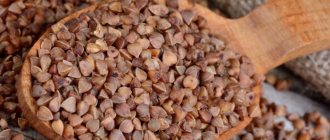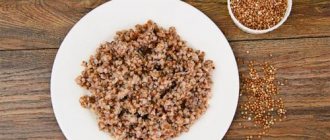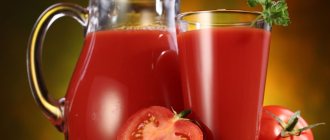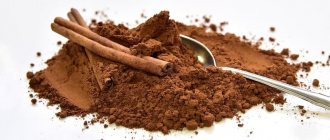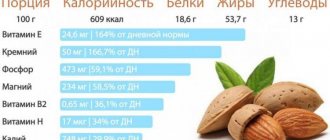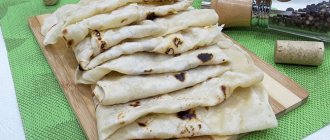How many times does buckwheat expand when cooked?
All of us have noticed how much buckwheat increases during cooking, but few have thought about the exact numbers, proportions and differences in volume. This unusual but useful topic will be discussed in this article.
There is a fairly common, persistent belief that the longer buckwheat is cooked, the more it expands. And this is most often associated with the fact that when cooked for a long time and kept in water, buckwheat, like any cereal, absorbs more moisture than when kept in liquid for a short time. This fact is true, confirmed by many years of experience and the attentive gaze of housewives, but practically does not provide any information regarding the proportions of the increase in the volume of cooked buckwheat and relatively raw buckwheat.
According to consumer reviews of various product manufacturers, on average 350-400 grams of boiled buckwheat will be obtained from 100 grams of dry buckwheat. The raw/cooked cereal ratio is 1:4. This figure may become controversial and change if the cereal is kept in water before cooking or becomes overcooked during the process. In this case, the final product weighs many times more than the unprocessed one.
Another important characteristic is volume. Dry buckwheat is approximately 2 times smaller in volume than boiled buckwheat.
In order to measure the exact weight of buckwheat, you need to cook it correctly, which we will talk about in the section below. Ready-made cereal can increase 5 or even more times if it is severely overcooked. A not entirely successful result may result if the water has completely boiled away, but cooking continues. It is buckwheat that has increased 3 times its personal volume that can indicate that it was prepared correctly and in compliance with all proportions of both water and the cereal itself.
Nowadays, ready-made buckwheat in cooking bags is quite common. On average, the weight of each bag is 50 grams. This finished product should weigh 150 grams.
Buckwheat has been a national product for many decades, and it is on the menu of every family. This universal side dish not only goes easily and tasty with almost any hot dish, but also has a number of positive properties, such as low calorie content, short cooking time and unpretentious storage of this product.
The list of dishes that can be prepared from this product is much longer than that of many other similar cereals: these are porridges, side dishes, combined with any meat, with butter, with various dressings; you can even make cutlets from buckwheat and add it to soups as additional thickener. It’s safe to say that in something like cooking, even at the everyday level, the ratio of products is an important point.
When cooking buckwheat normally, you will need 2.5 parts of water and 1 part of the cereal itself. For example, to cook 80 grams of cereal you will need about 160-200 ml of water, which is approximately the volume of one cut glass.
For information on how to properly cook buckwheat, see below.
Composition and beneficial properties of boiled buckwheat
If you adhere to a healthy diet, then your diet will not be complete without buckwheat, because its composition is very beneficial for the body. Porridge from this cereal has many vitamins, such as B5, B6, A, PP, E, folic acid. It contains micro- and macroelements: potassium, magnesium, sodium, phosphorus, calcium, iron, manganese, copper, zinc, selenium. Slow carbohydrates, which are found in buckwheat, help quickly saturate the body for a long time.
Due to its beneficial properties, many doctors recommend consuming this cereal for significant excess weight, varicose veins, diabetes, arthritis, hemorrhoids, atherosclerosis, diseases of the gastrointestinal tract and cardiovascular system. Nutritionists include it in the diet of those who want to lose weight faster, although buckwheat is high in calories. The fatty acids that make up the porridge are considered polyunsaturated, therefore they lower cholesterol levels and speed up metabolism in the body.
The low glycemic index allows people with diabetes to replace baked goods and potatoes with buckwheat. Most of the fiber in porridge prevents all carbohydrates from being absorbed, so blood sugar does not rise. Folic acid is necessary for women in the first trimester of pregnancy, because this element prevents the development of pathologies in the fetus. It is also useful in stimulating hematopoiesis and increases the body’s resistance to radiation and other harmful external environmental factors.
- How to check your computer's power supply
- Ground beef cutlets
- Unusual signs of heart failure that are important to pay attention to in time
Buckwheat contains a lot of protein (13%), which contains 18 amino acids. Porridge is compared to chicken eggs and milk powder in terms of the presence of essential elements. Traditional medicine advises drinking a decoction of buckwheat during viral colds. For dry coughs, it is used for expectoration. Ointments with buckwheat flour are used to treat skin diseases and malignant tumors.
Calorie content of boiled buckwheat in water without oil
During the cooking process, buckwheat grains swell almost three times. If you put 100 g of dry porridge in water to boil, then the calorie content will be equivalent to 300 g of ready-made porridge. Sometimes the calorie number changes due to temperature, so the final number becomes slightly smaller. As a result, the calorie content of boiled buckwheat is 92-110 kcal per 100 grams of the finished product. This number varies depending on the type of cereal.
During the cooking process, beneficial substances remain in the porridge. Vitamins B, A, PP, E, folic acid do not evaporate. Micro- and macroelements have a beneficial effect on the body when cereal is consumed daily. According to nutritionists, if you want to lose weight, buckwheat porridge should be prepared without salt and oil. Many people recommend not even boiling it, but pouring boiling water over it overnight. Children's doctors advise starting complementary feeding for infants with buckwheat porridge without milk.
- Gooseberry wine - step-by-step recipes for making it at home
- How remote workers will work in Russia
- Where to go if you become infected with COVID-19 at work
With milk
The calorie content of buckwheat cooked with milk is higher than that of cereal cooked with water. The figure depends on the milk you choose, or more precisely, the percentage of fat content. Choose a low-fat option to reduce your calorie intake. If you follow a mono-diet or any other diet, refuse to use homemade whole milk.
Calorie content of 100 g of buckwheat boiled in milk is 340-360 kcal. Proteins in the composition are 12-16 grams, fats are 3 g, the remaining components are slow carbohydrates. In case of allergic reactions, young children are advised to drink goat's milk; it is not so hard on the stomach. If this is not possible, try diluting the whole natural product with water in a 2:1 ratio. By adding dried fruits and nuts to your buckwheat diet, you will be full almost the whole day.
With salt and butter
If you don’t want to limit yourself to dairy first courses, then introduce buckwheat for dinner. Combining it with light salads or simply adding salt and butter, one serving of porridge will be enough to satisfy your appetite. Some gourmets add sauteed onions to buckwheat, adding a new taste and reducing the number of calories. To avoid getting tired of the mono-diet after 3-4 days, try cooking buckwheat in meat broth.
If you calculate the energy value of a dish, then the calorie content of 100 g of buckwheat with salt will be 105-115 grams. The figure depends on the cooking method and the level of salinity. The calorie content of a 100-gram serving of buckwheat with butter (12 g) is 155 kcal. Have full-fledged fasting days, consuming mono-products. To cleanse the intestines, it is recommended to pour a third of a glass of dry buckwheat with kefir, leave overnight, and drink the mixture in the morning. The body will feel better!
How many grams of buckwheat in a glass (table)
One glass contains 200 ml. holds 170 g of buckwheat (buckwheat)
1 glass contains 250 ml. holds 210 g of buckwheat (buckwheat)
A 100 gram glass holds 85 grams of buckwheat (buckwheat)
| A glass of buckwheat | Buckwheat weight in grams |
| Faceted glass of buckwheat until risky (200 ml.) | 170 grams of buckwheat |
| Faceted glass of buckwheat to the brim (250 ml.) | 210 grams of buckwheat |
| A regular glass contains 250 ml. | 210 grams of buckwheat |
| In a tea glass up to the rim (200 ml.) | 170 grams of buckwheat |
| In a plastic glass 100 ml. | 85 grams of buckwheat |
Attention! If you need to measure (measure) the exact amount of buckwheat in a small quantity, the easiest way is to use a teaspoon or a tablespoon. In order to use this information, go to the article how many grams of buckwheat are in a tablespoon.
How and how much to cook buckwheat?
In this post I want to tell you the basics of cooking buckwheat. We are not born cooks, we cook and learn from our mistakes. So how to cook buckwheat correctly?
In total, buckwheat is cooked for 15 – 20 minutes.
Milk buckwheat porridge is cooked for 35 minutes.
Ingredients:
General tips:
- When buckwheat is cooked, there is no need to stir it.
- It is advisable to cook buckwheat in a cauldron or pan made of dense metal.
- So that the ready-made buckwheat evaporates well, wrap it in a blanket or towel for 20-30 minutes.
- Buckwheat is an excellent side dish; it is served with herbs, fried onions, butter or mushrooms.
- Calorie content of finished buckwheat: 335 kcal per 100 grams of product.
How much water should be added to cook buckwheat porridge?
The ideal proportion is 2.5 to 1, that is, you need to add 2.5 times more water than cereal. For example, for a glass of buckwheat, add 2.5 glasses of water.
When should you salt buckwheat porridge?
Buckwheat is salted at the beginning of cooking, that is, we pour the cereal into already salted water.
How much does buckwheat expand in volume when cooked?
The volume of buckwheat increases 2 times.
How to cook buckwheat in a bag?
We put 1.5 liters of water in a saucepan, put it on fire, boil, salt and put in a bag of cereal. Cook for 15 minutes. Then we take out the bag, cut it and pour the finished porridge onto a dish.
How and how long should you cook buckwheat in a double boiler?
For 1 cup of buckwheat, take 2 cups of water and cook for 40 minutes. Before putting buckwheat in a double boiler, salt the dish and add butter.
How and how long should you cook buckwheat in a slow cooker?
We put the buckwheat in the multicooker, add water, maintaining the proportions of 1:4, set the multicooker to the special “Buckwheat” mode, but if there is no such mode, you can select “Milk porridge”. Cook for 20 minutes.
How and how long should you cook buckwheat in a pressure cooker?
Place the buckwheat in a pressure cooker, pour water in the ratio: 2 cups of liquid per glass of buckwheat. Cook for 20 minutes.
How and how long to cook buckwheat in the microwave?
Place the buckwheat in a microwave-safe container, add water in a 1:2 ratio, cover with a lid and place in the microwave. Set the maximum power (800-1000 W) and cook for 4 minutes, then switch to medium power and cook for another 15 minutes.

